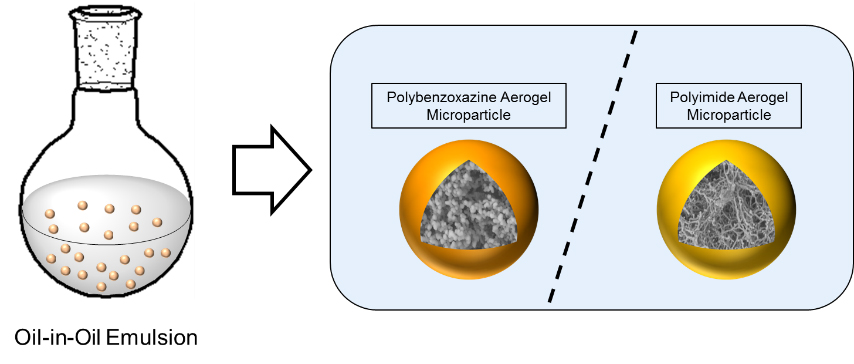Polymer Engineering Researchers Report Aerogel Microparticles
 Aerogels, the extremely light, 90-95% porous solids filled with air with pore diameter between 2-200 nm, are mostly reported in literature as bulk monoliths or sheets of characteristic dimensions several centimeters to hundreds of centimeter. Professor Sadhan C. Jana and his student Dr. Senlong Gu devised an oil-in-oil emulsion strategy, for the first time, to produce micrometer size, spherical aerogel particles with the same properties as the bulk aerogel monoliths. The sol-gel reactions that produce the mesoporous gel are carried out inside the micrometer size droplets created in an oil-in-oil emulsion system. The oil-in-oil emulsion system is obtained by dispersing in cyclohexane the droplets of the sols of polybenzoxazine (PBZ) or polyimide (PI) prepared in dimethylformamide. Finally, the aerogel microparticles are recovered using supercritical drying of the gel microparticles. The PBZ and PI aerogel microparticles prepared in this manner show mean diameter respectively 32.7 µm and 40.0 µm, mesoporous internal structures, and surface area respectively 55.4 m2/g and 512.0 m2/g. Carbonization of PBZ aerogel microparticles maintains the mesoporous internal structures but yields narrower pore size distribution. Such aerogel microparticles are useful in preparation of electrodes in batteries, drug delivery, and cleaning of noxious liquids from difficult to reach crevices. A more detailed information on the work can be found in the publication Langmuir, 32(22), 5637-5645 (2016).
Aerogels, the extremely light, 90-95% porous solids filled with air with pore diameter between 2-200 nm, are mostly reported in literature as bulk monoliths or sheets of characteristic dimensions several centimeters to hundreds of centimeter. Professor Sadhan C. Jana and his student Dr. Senlong Gu devised an oil-in-oil emulsion strategy, for the first time, to produce micrometer size, spherical aerogel particles with the same properties as the bulk aerogel monoliths. The sol-gel reactions that produce the mesoporous gel are carried out inside the micrometer size droplets created in an oil-in-oil emulsion system. The oil-in-oil emulsion system is obtained by dispersing in cyclohexane the droplets of the sols of polybenzoxazine (PBZ) or polyimide (PI) prepared in dimethylformamide. Finally, the aerogel microparticles are recovered using supercritical drying of the gel microparticles. The PBZ and PI aerogel microparticles prepared in this manner show mean diameter respectively 32.7 µm and 40.0 µm, mesoporous internal structures, and surface area respectively 55.4 m2/g and 512.0 m2/g. Carbonization of PBZ aerogel microparticles maintains the mesoporous internal structures but yields narrower pore size distribution. Such aerogel microparticles are useful in preparation of electrodes in batteries, drug delivery, and cleaning of noxious liquids from difficult to reach crevices. A more detailed information on the work can be found in the publication Langmuir, 32(22), 5637-5645 (2016).
